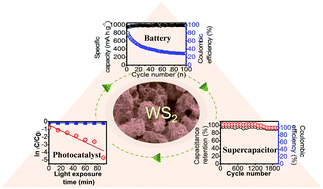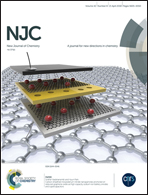Lithium ion storage ability, supercapacitor electrode performance, and photocatalytic performance of tungsten disulfide nanosheets†
Abstract
Although tungsten disulfide (WS2), an analogue of graphite, has long been pursued as a promising energy storage material due to its unique layered structure, structural changes, volumetric expansion and poor electronic conductivity have limited its practical use. Here, we report the synthesis of porous WS2 composed of a few layered nanosheets (P-WS2) using a simple and scalable hydrothermal method, as well as its electrochemical properties when used for a lithium storage electrode, a supercapacitor electrode, and a visible light active photocatalytic material. P-WS2 as an anode for lithium-ion batteries showed a high specific capacity of 292 mA h g−1 at a current density of 0.2C with excellent cycling stability over 100 cycles. The half-cell electrochemical assembly test demonstrated that P-WS2 delivered 241.5 F g−1 at a current density of 0.75 A g−1 and showed excellent stability over 2000 consecutive charge–discharge cycles. P-WS2 nanosheets exhibited 10 times higher photocatalytic activity than bulk commercial WS2 (C-WS2) for the degradation of Rhodamine B dye under visible light irradiation. The excellent performance of P-WS2 is due to its sheet-like structure, porous characteristics, and high surface area.



 Please wait while we load your content...
Please wait while we load your content...